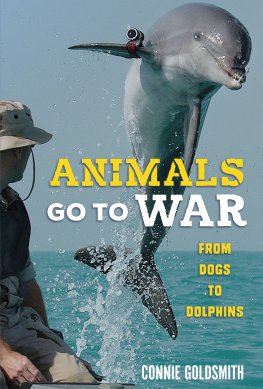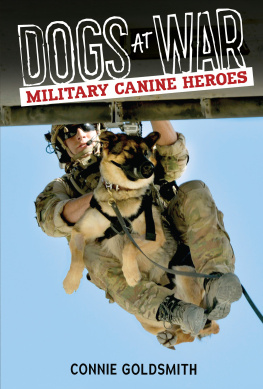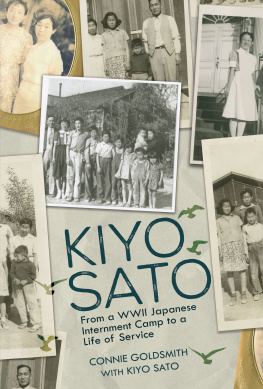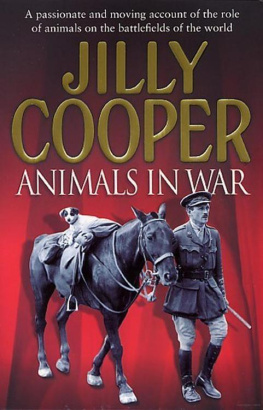This book is dedicated to the millions of animals that have served humankind in war and in peace.
Text copyright 2019 by Connie Goldsmith
All rights reserved. International copyright secured. No part of this book may be reproduced, stored in a retrieval system, or transmitted in any form or by any meanselectronic, mechanical, photocopying, recording, or otherwisewithout the prior written permission of Lerner Publishing Group, Inc., except for the inclusion of brief quotations in an acknowledged review .
Twenty-First Century Books
A division of Lerner Publishing Group, Inc.
241 First Avenue North
Minneapolis, MN 55401 USA
For reading levels and more information, look up this title at www.lernerbooks.com .
Main body text set in Adobe Garamond Pro 11/15.
Typeface provided by Adobe Systems.
Library of Congress Cataloging-in-Publication Data
Names: Goldsmith, Connie, 1945 author.
Title: Animals go to wa r : from dogs to dolphins / by Connie Goldsmith.
Description: Minneapolis, M N : Twenty-First Century Books, 2019 . | Includes bibliographical references and index . | Audience: 1318.
Identifiers: LCCN 2017060318 (print ) | LCCN 2018000584 (ebook ) | ISBN 781541524804 (eb pdf ) | ISBN 781512498042 (l b : alk. paper)
Subjects: LCSH: AnimalsWar useJuvenile literature . | AnimalsWar useHistoryJuvenile literature.
Classification: LCC UH87 (ebook ) | LCC UH87 .G65 2019 (print ) | DDC 355.4/24dc23
LC record available at https://lccn.loc.gov/2017060318
Manufactured in the United States of America
1-43531-33329-4/5/2018
9781541538139 ePub
9781541538146 ePub
9781541538153 mobi
Contents
Chapter 1
Comrades in War: Judy and Frank
Chapter 2
Armored Tanks of the Ancient World: Elephants
Chapter 3
Loyal and True: Horses
Chapter 4
Beasts of Burden: Mules and Camel6
Chapter 5
Feathered Heroes: Pigeons
Chapter 6
Mans Best Friend: Dogs
Chapter 7
Lucky Charms and Atomic Pigs
Chapter 8
Animals in The Twenty-First Century
Chapter 1
Comrades
in War
Judy and Frank
One of the only good things about war was the love that grew between the soldiers and their animals. For a man far from home, frightened, alone, facing death, a horse, an ox, or even a ferret mascot, who could return affection, was an immeasurable comfort.
Jilly Cooper, Animals in War , 2006
O n June 26, 1944, toward the end of World War II (19391945), the Japanese ship Harukiku Maru was steaming through the Strait of Malacca between Malaysia and Indonesia. On its way to Singapore, the vessel held more than eleven hundred prisoners of war (POWs)mostly British and Australianjammed into its holds. A British submarine, not realizing the Harukiku Maru was carrying friendly Allied soldiers, fired two torpedoes into the ship, ripping it apart and blowing passengers into the turbulent water.
Prisoner of War # 81A was one of the lucky ones, escaping through a porthole just before the Harukiku Maru sank. The POW was a good swimmer and could have reached shore easily. Instead, # 81A rescued at least four drowning men by ferrying them to pieces of floating debris or rescue boats.
As exhaustion set in and POW # 81A could no longer swim, two other POWs lifted her from the sea. They hid her under a sail along with dead soldiers so none of the Japanese who looked into their boat would see her. She was more dead than alive, one survivor recalled. She had totally given herself to the drowning men.
Who was POW # 81A? Judya purebred English pointer.
Gunboat Judy
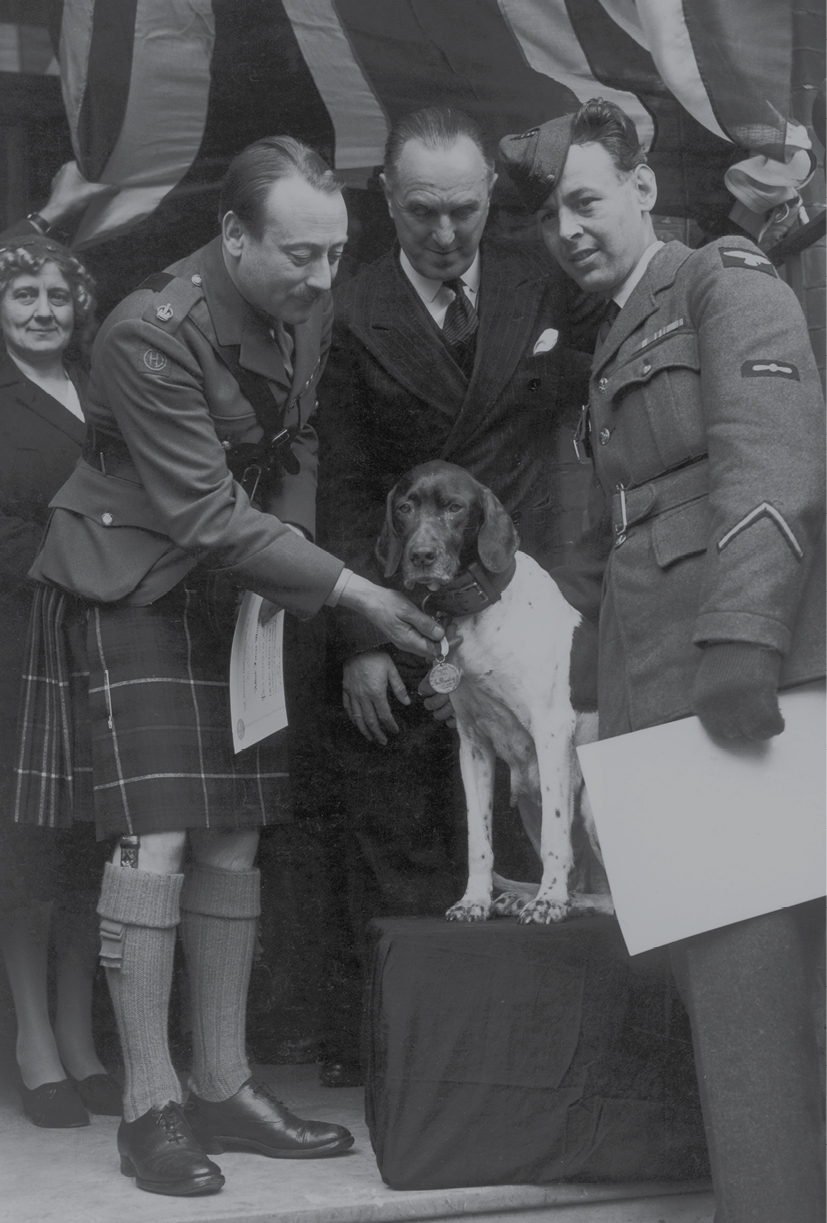
Judy the English pointer receives a Dickin Medal in London on May 2, 1946. On the right is Judys owner, airman Frank Williams. He received the White Cross of St. Giles for bravery in saving an animal. Judy spent three and one-half years in Japanese prisoner-of-war camps and narrowly escaped death many times during the war.
Judy wasnt always a hero. In 1936, before the start of the war, she was a runaway pup from a breeding kennel in Shanghai, China. A girl named Lee Ming who worked at the kennels found the lost puppy in the busy streets of the city and took her back to the kennels. She called the puppy Shudi, which means peaceful one in Wu, the local Chinese dialect. The head of the kennel, who was British, called the puppy Judy. Wealthy British families in Shanghai adopted Judys littermates. But Judys fate would be very different from theirs.
When Judy was born, China controlled Shanghai, one of its most important cities. Shanghai had a large community of Americans, British, and other foreigners who lived and traded with the Chinese. Five years earlier, in 1931, Japan had taken over Manchuria, a part of China northeast of Shanghai. In 1932 the Japanese bombed Shanghai in a vicious attack hoping to gain more land. After a few weeks of fierce fighting between Japanese and Chinese forces, the League of Nations (a peacekeeping organization that preceded the United Nations) forced a treaty between the two countries. The agreement allowed only a few Japanese troops to remain in Shanghai along with the many international citizens and their military representatives. To protect against further Japanese aggression in Shanghai, the British kept part of its Royal Navy in China. It also maintained a fleet of small maneuverable gunboats on the Yangtze River, which flows into the East China Sea.
A few months after Lee Ming returned Judy to her kennels, two British sailors from the gunboat HMS Gnat visited the kennels looking for a ship mascot. When Charles Jeffery, the Gnat s bosun (the person in charge of ship maintenance), whistled at Judy, she jumped into his arms. He took Judy back to the ship. She is the most lovable creature, Jeffery wrote in his diary. The ships company love and treat Judy as a pet, and I am delighted that the men share her. By the next year, China and Japan were at war. The British were then neutral. But Japanese planes harassed and attacked the Gnat and other British gunboats on the Yangtze. Judy heard the planes and howled to warn her shipmates of incoming enemy aircraft.
With the threat of world war on the horizon, Judy and her human shipmates transferred to a bigger gunboat called the HMS Grasshopper . They steamed to Singapore, home to Britains largest naval base in the Pacific region. Frank Williams, a member of the British Royal Air Force (RAF), arrived in Singapore in 1941. On December 7, 1941, the Japanese attacked the US naval base at Pearl Harbor, Hawaii. The day after the surprise attack, the United States declared war on Japan and officially entered World War II. Together, Britain, Australia, the United States, and other allies fought the Japanese in the Pacific. In Europe US troops joined Britain, France, and the Soviet Union (a union of republics that included Russia) to fight the armies of Adolf Hitlers Nazi Germany and other members of the Axis powers.
Prisoners of War
In Shanghai chaos reigned as the Japanese hunted down and bombed British boats in the South China Sea and on the Yangtze River. In February 1942, Williams and Judy were on separate gunboats about 40 miles (64 km) apart. The Japanese bombed and sank both boats. Williams and his crewmates escaped from their sunken boat, as did Judy and the crew of the Grasshopper . Judy set out with the Grasshopper s crew through the jungles of Sumatra (an island in Indonesia), hoping to evade the Japanese. Judy survived a crocodile attack and chased off a tiger to help her friends. Williams and his crew escaped by truck and then by boat. He happened to spot Judy headed into the jungle and wondered what an English pointer was doing there.

